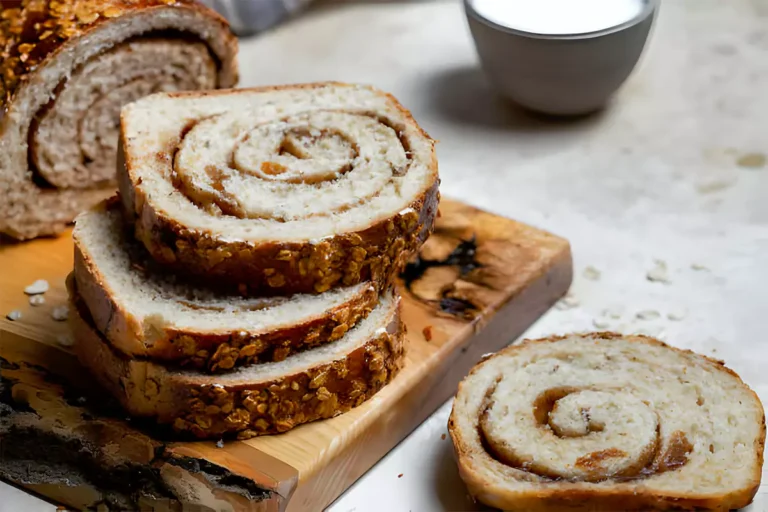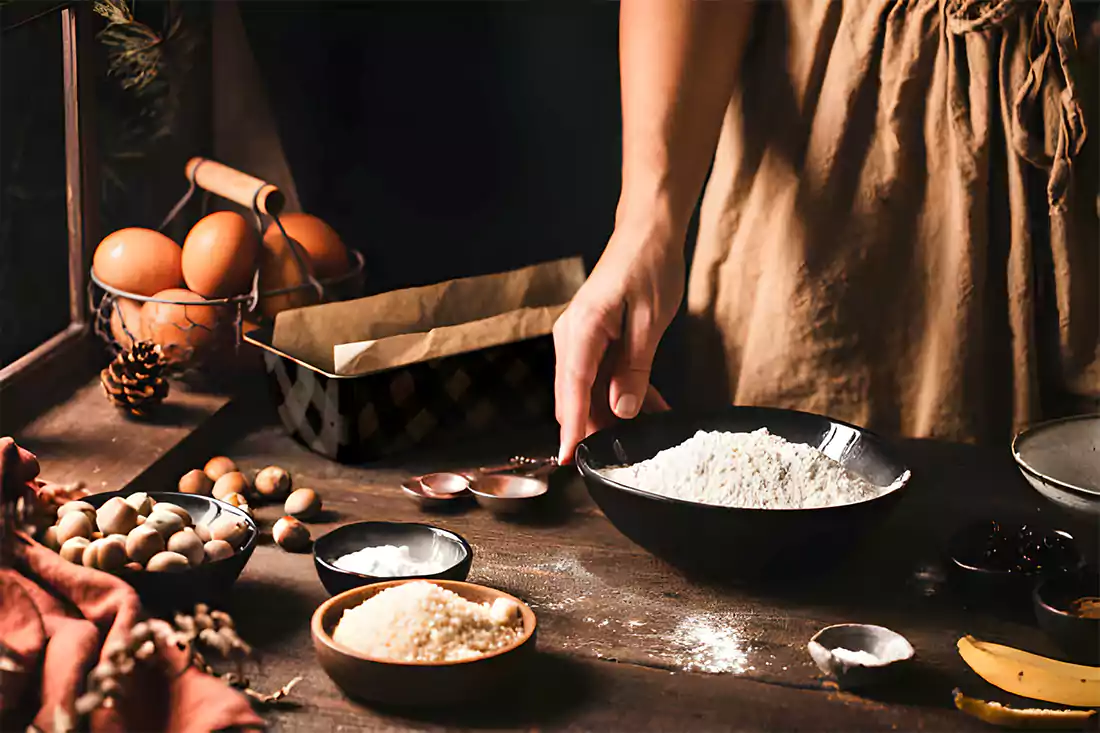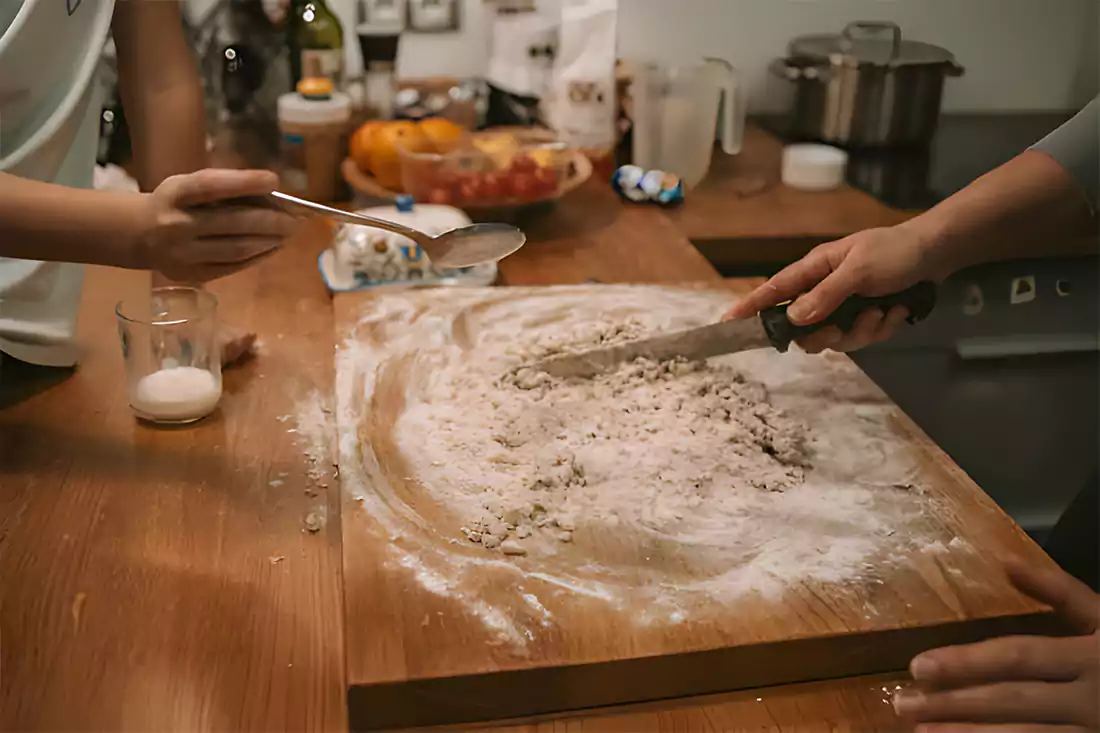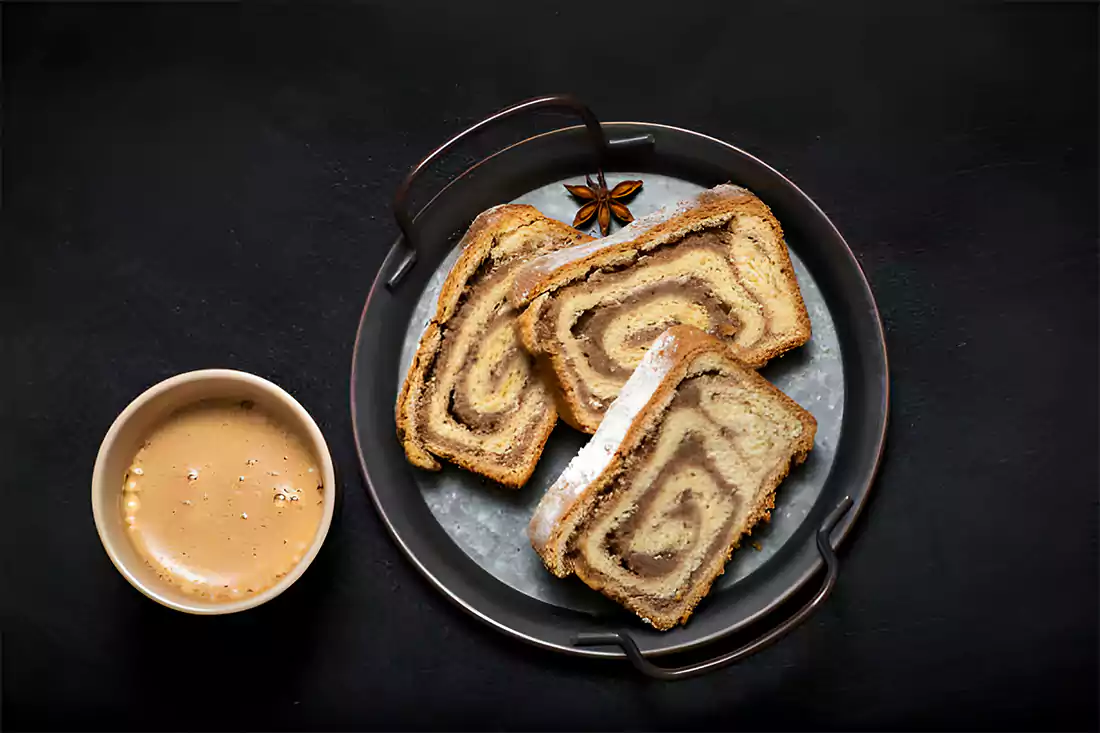Discover the Charm of Our Cinnamon Bread Recipe
Ah, this Cinnamon Bread Recipe—the mere mention conjures images of cozy mornings and comforting, sweet bites from freshly baked cinnamon bread. But what’s the big deal about this swirly, spicy delight? Well, for starters, it’s a recipe that’s as forgiving as it is delicious, making it a fantastic project for bakers of all stripes.
Why Our Cinnamon Bread Recipe Stands Out
Homemade cinnamon bread isn’t just a treat; it’s an experience. From the moment you mix the simple ingredients to the final slice, every step is filled with anticipation. And let’s not forget the aroma—oh, the aroma! It’s like a warm hug for your senses, filling your kitchen with a scent that’s both comforting and invigorating.
Ease and Comfort: The Essence of Our Cinnamon Bread Recipe
Now, don’t go thinking that making cinnamon bread is akin to climbing Mount Everest. In fact, it’s quite the opposite. With a handful of pantry staples and a bit of elbow grease, you’re well on your way to a loaf that’s as beautiful to look at as it is to eat. And the best part? This bread is the epitome of comfort food, perfect for those days when you need a little pick-me-up or a sweet treat to accompany your morning coffee.
So, roll up your sleeves and let’s get baking. After all, there’s nothing quite like the satisfaction of slicing into a loaf of cinnamon bread you made from scratch. And who knows? This might just become your new go-to recipe for when you’re in the mood for something sweet, spicy, and oh-so-delicious.
Key Ingredients and Smart Substitutes for Cinnamon Bread
Embarking on the cinnamon bread journey, the first stop is the pantry. The beauty of this recipe lies in its simplicity, using ingredients that are likely already nestled in your kitchen. But fear not, for the adventurous and the dietary restricted, there are plenty of twists and turns we can take.
Ingredients Overview
To whip up a classic loaf of cinnamon bread, you’ll need the usual suspects: all-purpose flour, sugar, a pinch of salt, and, of course, the star of the show—cinnamon. Eggs, milk, and a fat component like oil or butter round out the list, ensuring your bread is moist and tender. Each ingredient plays a pivotal role, from the flour providing structure to the cinnamon adding that unmistakable warmth.
Substitutions and Variations
Now, here’s where things get interesting.For those looking to tweak the recipe, whether due to dietary restrictions or a simple desire to experiment, there’s ample room for creativity, much like the innovative approaches found in The Ultimate Guide to Moist Bundt Cakes..Gluten-free? Swap in a trusty gluten-free flour blend. Dairy-free? Almond or oat milk can step in for regular milk, and there are numerous butter alternatives on the market.
Variations abound, too. Fancy a nutty crunch? Throw in some chopped walnuts or pecans. Dreaming of a fruitier twist? Dried cranberries or fresh apple chunks can make your cinnamon bread sing a whole new tune. And for an extra layer of decadence, a simple vanilla icing drizzle can elevate your loaf from comforting to downright indulgent.
In the realm of cinnamon bread, the possibilities are as limitless as your imagination. So, whether you’re sticking to the classic or venturing into new territory, the key is to have fun and make it your own. After all, that’s the beauty of baking—taking a handful of ingredients and transforming them into something truly special.
Your Guide to Mastering the Cinnamon Bread Recipe
First of all, with our ingredients ready and substitutions noted, it’s time to dive into the heart of baking cinnamon bread. The process is a delightful journey, from mixing the batter to pulling a golden loaf from the oven. Let’s break it down, shall we?
Preparation Steps
First things first, preheat your oven to the right temperature. A cozy 350°F (or 177°C) usually does the trick. Then, grease your loaf pan to ensure your bread will slide out effortlessly once baked.
Now, onto the batter: start by whisking together your dry ingredients—flour, baking soda, and a touch of salt, using tips from Avoiding Bundt Cake Dryness to ensure a moist and tender loaf. In a separate bowl, mix the wet ingredients. This usually involves beating an egg with sugar until it’s nice and smooth, then stirring in the oil (or melted butter), milk, and a generous splash of vanilla extract for that comforting aroma.
The magic happens when you combine the wet and dry ingredients. Stir them together until just combined, being careful not to overmix. Overzealous stirring can lead to tough bread, and we’re all about that tender crumb.
Baking and Cooling
Pour half of your batter from the Cinnamon Bread Recipe into the prepared pan, ready to transform into a fragrant loaf. Then, sprinkle a generous layer of cinnamon sugar over it. This is your moment to shine—don’t skimp on the cinnamon sugar! Pour the rest of the batter on top and finish with another sprinkle of cinnamon sugar. A quick swirl with a knife will create those beautiful marbled patterns that make cinnamon bread so visually appealing.
Slide the pan into the oven and bake, drawing inspiration from Rant Food’s innovative cinnamon raisin bread breakfast ideas to start your day with a twist. Patience is key here; baking times can vary, so keep an eye on your loaf and test it with a toothpick. When it comes out clean, your bread is ready to embrace the world.
Cooling is just as crucial as baking. Let the bread from your Cinnamon Bread Recipe cool in the pan for a bit before transferring it to a wire rack for the perfect finish. This allows the bread to set and makes slicing much easier (and who can resist a warm slice of cinnamon bread?).
And there you have it—a step-by-step guide to creating a loaf of cinnamon bread that’s sure to impress. Whether you’re a baking novice or a seasoned pro, the joy of slicing into your homemade bread is a reward in itself. So, preheat those ovens and get ready to fill your kitchen with the irresistible aroma of baking bread.
Ingredients:
For the Bread:
- 2 cups all-purpose flour
- 1 teaspoon baking soda
- 1/2 teaspoon salt
- 1 cup granulated sugar
- 1 large egg, at room temperature
- 1/4 cup vegetable oil
- 1 cup buttermilk, at room temperature
- 1 teaspoon vanilla extract
For the Cinnamon Swirl:
- 1/3 cup granulated sugar
- 2 teaspoons ground cinnamon
Optional for Topping:
- 2 tablespoons granulated sugar
- 1/2 teaspoon ground cinnamon
Directions:
- Preheat the Oven and Prepare the Pan:
- Preheat your oven to 350°F (175°C).
- Grease a 9×5 inch loaf pan or line it with parchment paper for easy removal.
- Mix Dry Ingredients:
- In a large bowl, whisk together the flour, baking soda, and salt. Set aside.
- Combine Wet Ingredients:
- In a separate bowl, beat the egg with the sugar until light and creamy.
- Add the vegetable oil, buttermilk, and vanilla extract, mixing well after each addition.
- Combine Wet and Dry Mixtures:
- Gradually add the wet ingredients to the dry ingredients, stirring just until combined. Be careful not to overmix to ensure a tender crumb.
- Prepare the Cinnamon Swirl:
- In a small bowl, mix together the cinnamon swirl ingredients (1/3 cup sugar and 2 teaspoons cinnamon).
- Assemble the Bread:
- Pour half of the batter into the prepared loaf pan.
- Sprinkle the cinnamon sugar mixture evenly over the batter.
- Top with the remaining batter, smoothing the top with a spatula.
- Add Optional Topping:
- If desired, mix the additional sugar and cinnamon for the topping and sprinkle it over the batter.
- Bake:
- Bake in the preheated oven for 45-50 minutes, or until a toothpick inserted into the center comes out clean.
- If the top browns too quickly, tent the bread with aluminum foil halfway through baking.
- Cool:
- Allow the bread to cool in the pan for about 10 minutes, then transfer it to a wire rack to cool completely.
- Serve:
- Slice the cooled cinnamon bread and serve as is, or toast and butter individual slices for a warm treat.
Enjoy your homemade cinnamon bread, perfect for breakfast, a snack, or a sweet treat any time of the day!
Pro Tips for Perfecting Your Cinnamon Bread
Now that our cinnamon bread is comfortably baking away, let’s sprinkle in some expert tips and tricks. These nuggets of wisdom will ensure your bread turns out perfectly every time, with that ideal swirl and mouthwatering moistness.
Baking Tips
Achieving the perfect cinnamon swirl is an art form in itself, and mastering it along with other advanced baking techniques can elevate your pastry skills, as noted by culinary experts. The key? Layering. When you add your cinnamon sugar, be generous but also strategic. You want a thick layer in the middle, but it’s crucial to leave a small border around the edges to prevent the filling from seeping out. And when you add the top layer of batter, do it gently. Dollop it on in sections, then carefully spread it to cover the cinnamon layer. This method helps maintain that distinct, swirly demarcation we all love.
Moisture is another critical factor in this Cinnamon Bread Recipe, ensuring each slice is perfectly tender, and understanding the Differences Between Bundt Cake and Regular Cake can offer insights into achieving the perfect texture. Nobody craves a dry loaf. The secret ingredient? Sour cream or yogurt. Adding a dollop of either can transform your bread, making it tender and moist. And remember, oil tends to bring more moisture to the party than butter, so consider your fat choices wisely.
Troubleshooting Common Issues
Even the most experienced bakers encounter hiccups now and then. If your bread is browning too quickly, tent it with aluminum foil. This simple trick allows the bread to continue baking without taking on too much color.
Is your bread too dense? Check your leavening agents. Baking soda and baking powder have shelf lives, and if they’re past their prime, they won’t do their job. And don’t forget the importance of not overmixing your batter. Mix just until the ingredients are combined to keep the crumb of your bread light and tender.
With these tips and tricks up your sleeve, you’re well on your way to baking cinnamon bread that’s not just good but great. Remember, baking is as much about the journey as it is about the destination. So, embrace the process, learn from each loaf, and most importantly, enjoy the fruits of your labor, one delicious slice at a time.
Best Ways to Serve and Enjoy Cinnamon Bread
Once your cinnamon bread has cooled and you’ve admired your handiwork, it’s time to think about serving and pairing. This bread isn’t just a treat; it’s a versatile player in your culinary repertoire, ready to elevate breakfasts, snacks, and even desserts.
Serving Suggestions
There’s something about a warm slice of cinnamon bread that feels like a hug. For an everyday indulgence, toast a slice and slather it with butter. The heat brings out the cinnamon’s warmth and makes the butter melt into every nook and cranny, creating a bite that’s simply divine.
Looking to impress with your Cinnamon Bread Recipe? Turn your cinnamon bread into an exquisite French toast, drawing inspiration from the festive flavors in <strong>Gingerbread Bundt Cake Recipe for a holiday twist. Dip slices in a mixture of beaten eggs, milk, and a dash of vanilla, then fry until golden. Serve with a drizzle of maple syrup and a dusting of powdered sugar for a breakfast that feels like dessert.
Pairing Ideas
Cinnamon bread is a star on its own, but it also plays well with others. For a cozy breakfast, pair it with a steaming cup of coffee. The bitterness of the coffee balances the sweetness of the bread, creating a harmonious start to your day.
And let’s not forget about tea. A spiced chai or a robust black tea complements the cinnamon’s warmth, making for a comforting afternoon snack. For something cooler, try a glass of cold milk. It’s a classic pairing that never goes out of style, especially if you’re sharing this treat with the little ones.
Whether you’re enjoying a slice on a lazy Sunday morning or sharing it with friends over a cup of tea, cinnamon bread has a way of making any moment feel special. So, slice it up, serve it in your favorite way, and watch as it brings smiles to faces. After all, that’s the true magic of baking—sharing the love, one slice at a time.
Level Up Your Cinnamon Bread with These Techniques
For those who’ve mastered the classic cinnamon bread and are itching to explore new horizons, this section is for you. Let’s delve into advanced techniques and exciting variations that can add a twist to your beloved recipe.
Advanced Baking Techniques
Elevating your Cinnamon Bread Recipe game might involve experimenting with different types of flour for a unique texture, much like the advanced techniques every pastry chef should know,</strong></strong> to infuse your bread with a professional touch. Whole wheat flour can add a nutty depth, while a touch of rye can introduce an intriguing complexity. Remember, these flours absorb more liquid, so adjustments may be necessary.
Another technique is to incorporate a streusel topping before baking. A mixture of flour, butter, sugar, and cinnamon creates a crumbly topping that adds texture and a burst of flavor. For an artistic touch, try scoring the top of your loaf with a sharp knife in a decorative pattern before baking. This not only adds visual appeal but can also control the bread’s expansion as it bakes.
Recipe Variations
Variations of cinnamon bread can range from subtle to bold. Consider adding a swirl of apple butter or pumpkin puree for a seasonal twist. These additions not only infuse the bread with flavor but also contribute to its moistness.
For a more decadent variation, incorporate chocolate chips or a ribbon of Nutella into the cinnamon swirl. The combination of chocolate and cinnamon is irresistible and adds a luxurious richness to every bite.
Additionally, you can also modify the recipe to create cinnamon bread muffins. These are ideal for on-the-go snacking or for those who prefer portion-controlled servings. Moreover, muffins bake faster and are a hit with both kids and adults. Consequently, you can simply adjust the baking time and temperature accordingly.
By exploring these advanced techniques and variations, you can keep the joy of baking cinnamon bread fresh and exciting. Each loaf or muffin batch becomes an opportunity to experiment and discover new favorite combinations. So, why not get creative and see where your baking adventures take you? After all, the best recipes are the ones that carry a personal touch.
Solving Your Cinnamon Bread Recipe Queries
As we near the end of our cinnamon bread journey, it’s time to address some frequently asked questions and troubleshoot common issues. Additionally, this section is designed to help you navigate the baking process with ease and ensure success in your kitchen.
Frequently Asked Questions
Q: Can I make cinnamon bread without a stand mixer?
A: Absolutely! While a stand mixer can make the process quicker, it’s entirely possible to mix your dough by hand. It might require a bit more elbow grease, but the results will be just as delicious.
Q: How do I know when my cinnamon bread is fully baked?
A: The best test is the toothpick test. Insert a toothpick into the center of the loaf; if it comes out clean or with a few moist crumbs, your bread is done. Also, the bread should pull away slightly from the sides of the pan, and the top should be golden brown.
Q: Why did my bread turn out dry?
A: Dry bread can result from overbaking, measuring flour incorrectly (always spoon and level, don’t scoop), or not adding enough fat or liquid to the batter. Make sure to follow the recipe closely and check your bread a few minutes before the minimum baking time just to be safe.
Troubleshooting Guide
Problem: My cinnamon swirl sank to the bottom.
Solution: First, this can happen if the batter is too thin or the cinnamon sugar is too heavy. Additionally, try mixing a little flour into your cinnamon sugar to help it stay in place. Furthermore, ensure your batter has the proper consistency.
Problem: The top of my bread is overbrowning but the inside isn’t done.
Solution: If the top of your bread is browning too quickly, loosely cover it with aluminum foil. This will deflect some of the heat and allow the bread to bake evenly without burning the top.
Problem: My bread is undercooked in the middle.
Solution: Ovens can vary, so it’s important to know yours. If your bread is consistently undercooked in the middle, consider lowering the oven temperature and extending the baking time. This allows the heat to penetrate more deeply without overcooking the exterior



